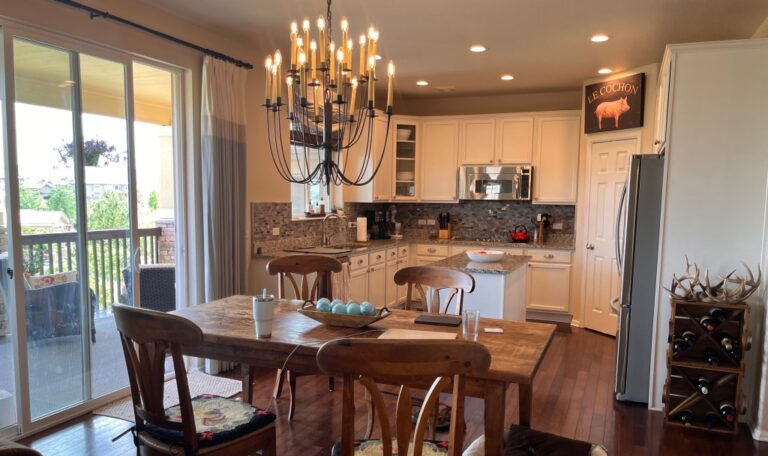Before: A young couple had been envisioning what they wanted for their kitchen for two years, but when they found out they were expecting a baby, the project took on new urgency. (Photo by Marni Jameson)
She wouldn't have been my daughter if we hadn't had major home renovation work going on late in the pregnancy, but there we were.
While I was pregnant with her and renovating our home in California, I remember standing in our ruined kitchen, surrounded by the sounds of hammers, drills, and no working appliances, when my water broke.
History repeats itself.
When Paige and her husband, Adam, bought their first home together in the Denver area two years ago, their 15-year-old kitchen and main bathroom were in need of renovation. The kitchen was small and felt outdated. The backsplash was cluttered. The old appliances weren't energy efficient. The thermometer markings on the stove were worn down. The refrigerator stuck out too far. And the builder-grade fixtures were boring.
Because they both love to cook and entertain, Paige wanted an eat-in kitchen with an island and room for two counter stools. Adam wanted a gas stove rather than electric. But the more they looked into the space, the more they felt this wasn't feasible, much less affordable. They lived with the status quo and pondered their options.
Then Paige found out she was pregnant, and her nesting instincts kicked in. Suddenly, resolving the kitchen problem became a top priority. “I needed to know if we could keep doing this or if we needed to think about moving,” she said.
They reached out to interior designer Kate Clapp, owner of Kate Saige Interiors, for some suggestions on how they could get the eat-in kitchen of their dreams and renovate their bathroom before the baby arrives, without knocking down walls or busting their budget.
After a few months, Clapp drew up plans and worked with the couple to select finishes and appliances. They installed gas line for a new stove. To expand the kitchen's floor and counter space, they tore out the walk-in pantry and replaced the oversized refrigerator with a deeper-counter unit. They planned to make up for the lack of pantry space with more cabinets and a smart storage system.
Demolition began in early April, eight weeks before Paige was due to give birth. Amazingly, thanks to meticulous planning, careful timing, and hard-working crews, baby George was able to come home to a beautiful new kitchen.

Here's what Paige and Adam learned along the way:
Best decision: They hired a reputable general contractor, Tim Sole, owner of Sole Construction, who was neither the lowest nor the highest bidder. Sole appointed a project manager and brought in quality tradesmen. When any issues arose, the general contractor stepped up to resolve them. The general contractor also made sure all the proper permits, housing association approvals, and inspections were obtained.
Guidance and options: “With every design decision, we felt guided, not pressured,” says Paige. “Nobody said we had to do this.” For example, when choosing whether to reupholster or replace the cabinets in their kitchen, the couple initially planned to reupholster to save money, but after looking at quotes, they realized that all new cabinets, which would really improve the kitchen, would only cost an additional $2,000. “If you're going to knock down a wall and change the footprint, you're going to want all new cabinets,” says Clapp. “But if the footprint is the same, reupholstering will save you money.” That said, she only recommends reupholstering if the cabinets have a good foundation.
A compromise: Both the designer and contractor respected the fact that this was a first-home project: “We weren't expecting top-of-the-line finishes,” says Paige. Clapp recommended installing a costly imitation tile for the backsplash and using the same engineered quartz throughout the kitchen and main bathroom, because using the same material would save money. They also opted for mid-range KitchenAid appliances.
The hardest part: Be patient. Though the project took just eight weeks from demolition to completion, it took the couple two years to think through what they wanted, save up, find a designer who could make it happen, get quotes, and find a contractor. Everyone involved agrees that the construction phase would have taken much longer without having every detail planned out and materials on site.
Pleasant surprise: “We were preparing for disaster,” Page says, “but because we chose the best professionals and didn't cut any corners, we were able to complete the project on time and slightly under budget.”
Pride factor: “Moving away would have been the easy way out,” Adam says, “but putting in the effort to turn what you have into what you want is so much more satisfying.”
Join me next week as I show you how to organize your new kitchen with a kitchen organizer.
Marni Jameson is the author of seven books, including Downsizing the Family Home. She can be reached at marni@marnijameson.com.


